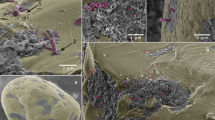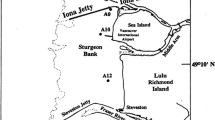Abstract
This study focused on organic particles withrespect to their transport and sedimentarymineralisation in a North Sea intertidalsandflat previously characterised as stronglyinfluenced by advective transport across andbelow the water-sediment interface. Measuredpermeabilities of the sandy sediment rangedfrom 5.5 to 41⋅10−12 m2, andpermeabilities calculated from granulometricdata exceeded the measured values by a factorof 4.4 ∓ 2.8. Bacteria (2–9% of the POC)were highly variable in space and time. Theywere less mobile than interstitial fine (<70 µm) organic and inorganic particles, aspart of the population lived attached to large,heavy sand grains. The vertical distribution ofbacteria was closely related to the organiccarbon content of the fine-grained interstitialmaterial. In winter, bacterial numbers in theuppermost 5 cm amounted to 39–69% of thesummer ones. Carbon mineralisation rates rangedbetween 20 mg C m−2 d−1 in winter and580 mg C m−2 d−1 in summer, keepingstep with finer-grained sediments thatcontained an order of magnitude more organiccarbon. Sedimentary carbohydrates were mainlyintracellular or tightly bound to particles,and their concentrations were depth-invariantin winter, but exponentially decreasing withdepth in summer. Below 5 cm depth, the meanconcentration was (1590 ∓830) µg cm−3, without major downcoreor seasonal changes. Phytobenthos andphytodetritus were dominated by diatoms andcomprised merely minor amounts of other primaryproducers. Planktonic diatom depth profileswere related to weather and phytoplanktonconditions, and benthic diatoms showed similardepth distributions due to passive and activemotion. The penetration of relatively freshphytodetritus down to at least 5 cm, shown bychloropigment composition, emphasised the closecoupling between water column and sandysediment, facilitated by advective interfacialand subsurface flows.
Similar content being viewed by others
References
Abele-Oeschger D (1991) Potential of some carotenoids in two recent sediments of Kiel Bight as biogenic indicators of phytodetritus. Mar. Ecol. Prog. Ser. 70: 83–92
Asmus RM &Bauerfeind E (1994) The microphytobenthos of Königshafen-spatial and seasonal distribution on a sandy tidal flat. Helgol. Meeresunters. 48: 257–276
Bianchi TS,Dawson R &Sawangwong P (1988) The effects of macrobenthic deposit-feeding on the degradation of chloropigments in sandy sediments. J Exp. Mar. Biol. Ecol. 122: 243–255
Boon AR &Duineveld GCA (1998) Chlorophyll a as a marker for bioturbation and carbon flux in southern and central North Sea sediments. Mar. Ecol. Prog. Ser. 162: 33–43
Boon AR,Duineveld GCA,Berghuis EM &van der Weele JA (1998) Relationships between benthic activity and the annual phytopigment cycle in near-bottom water and sediments in the Southern North Sea. Est. Coast. Shelf Sci. 46: 1–13
Canfield DE,Thamdrup B &Hansen JW (1993) The anaerobic degradation of organic matter in Danish coastal sediments: Iron reduction, manganese reduction, and sulfate reduction. Geochim. Cosmochim. Acta 57: 3867–3883
Dade WB,Davis JD,Nichols PD,Nowell ARM,Thistle D,Trexler MB &White DC (1990) Effects of bacterial exopolymer adhesion on the entrainment of sand. Geomicrobiol. Journal 8: 1–16
Darcy HPG (1856) Les Fontaines Publiques de la Ville de Dijon. Victor-Dalmont, Paris
Decho AW &Lopez GR (1993) Exopolymer microenvironments of microbial flora: Multiple and interactive effects on trophic relationships. Limnol. Oceanogr. 38: 1633–1645
Eggleston J &Rojstaczer S (1998) Inferring spatial correlation of hydraulic conductivity from sediment cores and outcrops. Geophys. Res. Letters 25: 2321–2324
Epstein SS &Rossel J (1995) Enumeration of sandy sediment bacteria: search for optimal protocol. Mar. Ecol. Prog. Ser. 117: 289–298
Flemming BW &Ziegler K (1995) High-resolution grain size distribution patterns and textural trends in the backbarrier environment of Spiekeroog Island (southern North Sea). Senckenbergiana maritima 26: 1–24
Forster S,Huettel M &Ziebis W (1996) Impact of boundary layer flow velocity on oxygen utilization in coastal sediments. Mar. Ecol. Prog. Ser. 143: 173–185
Gätje, C. &Reise, K. (1998) Ökosystem Wattenmeer: Austausch-, Transport-und Stoffumwandlungsprozesse. Springer, Berlin
Goodwin TW (1980) The Biochemistry of the Carotenoids. Chapman & Hall
Grant J &Gust G (1987) Prediction of coastal sediment stability from photopigment content of mats of purple sulphur bacteria. Nature 330: 244–246
Harvey HR,Tuttle JH &Bell JT (1995) Kinetics of phytoplankton decay during simulated sedimentation: Changes in biochemical composition and microbial activity under oxic and anoxic conditions. Geochim. Cosmochim. Acta 59: 3367–3377
Hasle GR,von Stosch HA &Syvertsen EE (1983) Cymatosiraceae, a new diatom family. Bacillaria 6: 9–156
Henrichs SM &Doyle AP (1986) Decomposition of 14C-labelled organic substances in marine sediments. Limnol. Oceanogr. 31: 765–778
Hsü KJ (1989) Physical Principles of Sedimentology. Springer, Berlin
Huettel M &Gust G (1992) Impact of bioroughness on interfacial solute exchange in permeable sediments. Mar. Ecol. Prog. Ser. 89: 253–267
Huettel M,Ziebis W &Forster S (1996) Flow-induced uptake of particulate matter in permeable sediments. Limnol. Oceanogr. 41: 309–322
Huettel M,Ziebis W,Forster S &Luther III GW (1998) Advective transport affecting metal and nutrient distributions and interfacial fluxes in permeable sediments. Geochim. Cosmochim. Acta 62: 613–631
Karsten U &Garcia-Pichel F (1996) Carotenoids and mycosporine-like amino acid compounds in members of the genus Microcoleus (cyanobacteria): a chemosystematic study. Systematic and Applied Microbiology 19: 285–294
Kingston MB (1999) Wave effects on the vertical migration of two benthic microalgae: Hantzschia virgata var. intermedia and Euglena proxima. Estuaries 22: 81–91
Klute A &Dirksen C (1986) Hydraulic conductivity and diffusivity: laboratory methods. In: Klute A (Ed.) Methods of Soil Analysis-part 1-Physical and Mineralogical Methods (pp 687–700). American Society of Agronomy
Kristensen E &Hansen K (1995) Decay of plant detritus in organic-poor marine sediment: production rates and stoichiometry of dissolved C and N compounds. J Mar. Res. 53: 675–702
Logan BE &Kirchman DL (1991) Uptake of dissolved organics by marine bacteria as a function of fluid motion. Mar. Biol. 111: 175–181
Nelson JR,Eckman JE,Robertson CY,Marinelli RL &Jahnke RA (1999) Benthic microalgal biomass and irradiance at the sea floor on the continental shelf of the South Atlantic Bight: Spatial and temporal variability and storm effects. Cont. Shelf Res. 19: 477–505
Nield DA &Bejau A (1992) Convection in Porous Media. Springer, Berlin
Osinga R,Kop AJ,Duineveld GCA,Prins RA &van Duyl FC (1996) Benthic mineralization rates at two locations in the southern North Sea. J Sea Res. 36: 181–191
Pankow H (1990) Ostsee-Algenflora. Gustav-Fischer-Verlag, Jena
Pilditch CA,Emerson CW &Grant J (1998) Effect of scallop shells and sediment grain size on phytoplankton flux to the bed. Cont. Shelf Res. 17: 1869–1885
Reimers CE,Glenn SM &Creed EL (1996) The dynamics of oxygen uptake by shelf sediments. EOS 76: OS202
Ritzrau W &Graf G (1992) Increase of microbial biomass in the benthic turbidity zone of Kiel Bight after resuspension by a storm event. Limnol. Oceanogr. 37: 1081–1086
Rowan KS (1989) Photosynthetic Pigments of Algae. Cambridge University Press, Cambridge
Rusch A,Huettel M &Forster S (2000) Particulate organic matter in permeable marine sands-dynamics in time and depth. Est. Coast. Shelf Sci. 51: 399–414
Sachs L (1997) Angewandte Statistik. Springer, Berlin
Sahm K,MacGregor BJ,Jørgensen BB &Stahl DA (1999) Sulphate reduction and vertical distribution of sulphate-reducing bacteria quantified by rRNA slot-blot hybridization in a coastal marine sediment. Env. Microbiol. 1: 65–74
Schories D,Albrecht A &Lotze H (1997) Historical changes and inventory of macroalgae from Königshafen Bay in the northern Wadden Sea. Helgol. Meeresunters. 51: 321–341
Shepherd RG (1989) Correlations of permeability and grain size. Ground Water 27: 633–638
Shum KT &Sundby B (1996) Organic matter processing in continental shelf sediments-the subtidal pump revisited. Mar. Chem. 53: 81–87
Sievert SM,Brinkhoff T,Muyzer G,Ziebis W &Kuever J (1999) Spatial heterogeneity of bacterial populations along an environmental gradient at a shallow submarine hydrothermal vent near Milos Island (Greece). Appl. Env. Microbiol. 65: 3834–3842
Smayda TJ (1978) From phytoplankters to biomass. In: Sournia A (Ed.) Phytoplankton Manual (pp 273-279). UNESCO, Paris
Smith DJ &Underwood GJC (1998) Exopolymer production by intertidal epipelic diatoms. Limnol. Oceanogr. 43: 1578–1591
Staats N (1999) Exopolysaccharide production by marine benthic diatoms. Ph.D. thesis, University of Amsterdam
Steenbergen CLM,Korthals HJ &Dobrynin EG (1994) Algal and bacterial pigments in non-laminated lacustrine sediment: studies of their sedimentation, degradation and stratigraphy. FEMS Microbiol. Ecol. 13: 335–352
Sun M,Aller RC &Lee C (1991) Early diagenesis of chlorophyll-a in Long Island Sound sediments: A measure of carbon flux and particle reworking. J Mar. Res. 49: 379–401
Sun M,Aller RC &Lee C (1994) Spatial and temporal distributions of sedimentary chloropigments as indicators of benthic processes in Long Island Sound. J Mar. Res. 52: 149–176
Underwood GJC,Paterson DM &Parkes RJ (1995) The measurement of microbial carbohydrate exopolymers from intertidal sediments. Limnol. Oceanogr. 40: 1243–1253
Upton AC,Nedwell DB,Parkes RJ &Harvey SM (1993) Seasonal benthic microbial activity in the southern North Sea; oxygen uptake and sulphate reduction. Mar. Ecol. Prog. Ser. 101: 273–281
Yallop ML,de Winder B,Paterson DM &Stal LJ (1994) Comparative structure, primary production and biogenic stabilization of cohesive and non-cohesive marine sediments inhabited by microphytobenthos. Est. Coast. Shelf Sci. 39: 565–582
Ziebis W,Huettel M &Forster S (1996) Impact of biogenic sediment topography on oxygen fluxes in permeable sediments. Mar. Ecol. Prog. Ser. 140: 227–237
Author information
Authors and Affiliations
Corresponding author
Rights and permissions
About this article
Cite this article
Rusch, A., Forster, S. & Huettel, M. Bacteria, diatoms and detritus in an intertidal sandflat subject to advective transport across the water-sediment interface. Biogeochemistry 55, 1–27 (2001). https://doi.org/10.1023/A:1010687322291
Issue Date:
DOI: https://doi.org/10.1023/A:1010687322291




